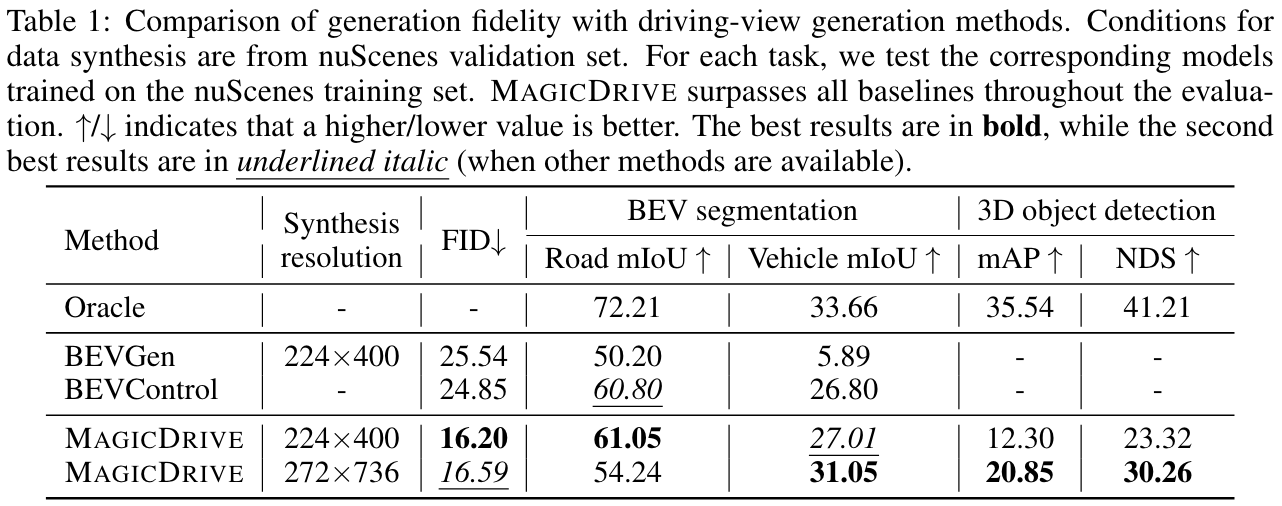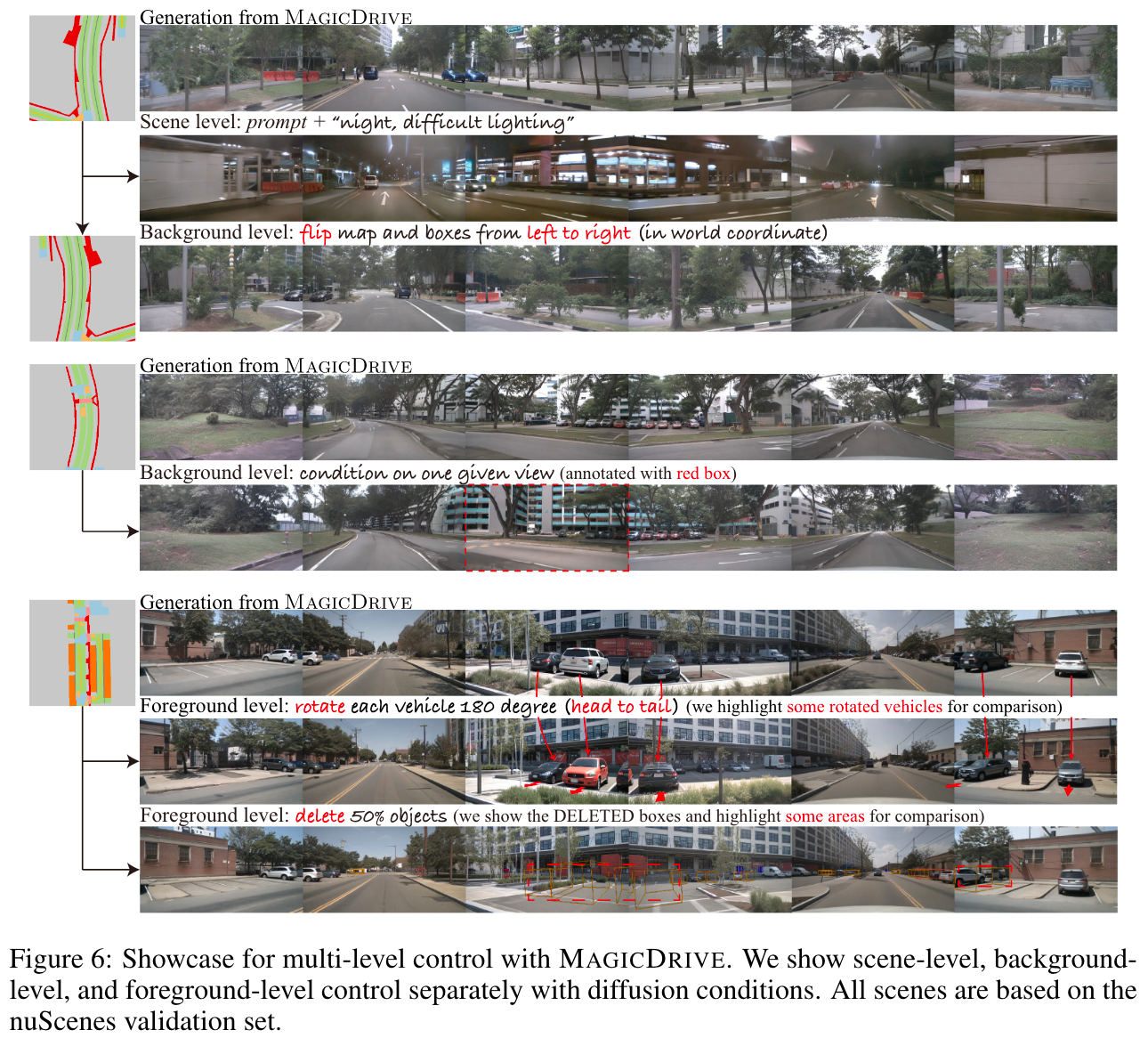✨ Check out our new work MagicDrive3D on 3D scene generation!
✨ If you want video generation, please find the code at the video branch.
Videos generated by MagicDrive (click the image to see the video).
This repository contains the implementation of the paper
MagicDrive: Street View Generation with Diverse 3D Geometry Control
Ruiyuan Gao1*, Kai Chen2*, Enze Xie3^, Lanqing Hong3, Zhenguo Li3, Dit-Yan Yeung2, Qiang Xu1^
1CUHK 2HKUST 3Huawei Noah's Ark Lab
*Equal Contribution ^Corresponding Authors
TL; DR MagicDrive generates high-quality street-view images & videos with diverse 3D geometry control and multiview consistency, which can be used as a data engine in various perception tasks.
Recent advancements in diffusion models have significantly enhanced the data synthesis with 2D control. Yet, precise 3D control in street view generation, crucial for 3D perception tasks, remains elusive. Specifically, utilizing Bird's-Eye View (BEV) as the primary condition often leads to challenges in geometry control (e.g., height), affecting the representation of object shapes, occlusion patterns, and road surface elevations, all of which are essential to perception data synthesis, especially for 3D object detection tasks. In this paper, we introduce MagicDrive, a novel street view generation framework, offering diverse 3D geometry controls including camera poses, road maps, and 3D bounding boxes, together with textual descriptions, achieved through tailored encoding strategies. Besides, our design incorporates a cross-view attention module, ensuring consistency across multiple camera views. With MagicDrive, we achieve high-fidelity street-view image & video synthesis that captures nuanced 3D geometry and various scene descriptions, enhancing tasks like BEV segmentation and 3D object detection.
- [2024/06/07] MagicDrive can generate 60-frame videos! We release the config: rawbox_mv2.0t_0.4.3_60.yaml. Check out our demos on the project page.
- [2024/06/07] We release pre-trained weight for 16-frame video generation. Check it out!
- [2024/06/01] We hold the W-CODA workshop @ECCV2024. Challenge track 2 will use MagicDrive as the baseline. We will release more resources in the near future. Stay tuned!
In MagicDrive, we employ two strategies (cross-attention and additive encoder branch) to inject text prompts, camera poses, object boxes, and road maps as conditions for generation. We also propose a cross-view attention module for multiview consistency.
- config and pretrained weight for base resolution (224x400)
- demo for base resolution (224x400)
- GUI for interactive bbox editing
- train and test code release
- FID test code
- config and pretrained weight for high resolution
Clone this repo with submodules
git clone --recursive https://github.com/cure-lab/MagicDrive.gitThe code is tested with Pytorch==1.10.2 and cuda 10.2 on V100 servers. To setup the python environment, follow:
# option1: to run GUI only
pip install -r requirements/gui.txt
# 😍 our GUI does not need mm-series packages.
# continue to install diffusers from `third_party`.
# option2: to run the full testing demo (and also test your env before training)
cd ${ROOT}
pip install -r requirements/dev.txt
# continue to install `third_party`s as following.We opt to install the source code for the following packages, with cd ${FOLDER}; pip -vvv install .
# install third-party
third_party/
├── bevfusion -> based on db75150
├── diffusers -> based on v0.17.1 (afcca39)
└── xformers -> based on v0.0.19 (8bf59c9), optionalsee note about our xformers. If you have issues with the environment setup, please check FAQ first.
Setup default configuration for accelerate with
accelerate configOur default log directory is ${ROOT}/magicdrive-log. Please be prepared.
Our training is based on stable-diffusion-v1-5. We assume you put them at ${ROOT}/pretrained/ as follows:
{ROOT}/pretrained/stable-diffusion-v1-5/
├── text_encoder
├── tokenizer
├── unet
├── vae
└── ...Download our pretrained weight for MagicDrive from onedrive and put it in ${ROOT}/pretrained/
Run our demo
👍 We recommend users run our interactive GUI first, because we have minimized the dependencies for the GUI demo.
cd ${ROOT}
python demo/interactive_gui.py
# a gradio-based gui, use your web browserAs suggested by #37, prompt is configurable through GUI!
Run our demo for camera view generation.
cd ${ROOT}
python demo/run.py resume_from_checkpoint=magicdrive-log/SDv1.5mv-rawbox_2023-09-07_18-39_224x400The generated images will be located in magicdrive-log/test. More information can be find in demo doc.
We prepare the nuScenes dataset similar to bevfusion's instructions. Specifically,
- Download the nuScenes dataset from the website and put them in
./data/. You should have these files:data/nuscenes ├── maps ├── mini ├── samples ├── sweeps ├── v1.0-mini └── v1.0-trainval
Tip
You can download the .pkl files from OneDrive. They should be enough for training and testing.
-
Generate mmdet3d annotation files by:
python tools/create_data.py nuscenes --root-path ./data/nuscenes \ --out-dir ./data/nuscenes_mmdet3d_2 --extra-tag nuscenes
You should have these files:
data/nuscenes_mmdet3d_2 ├── nuscenes_dbinfos_train.pkl (-> ${bevfusion-version}/nuscenes_dbinfos_train.pkl) ├── nuscenes_gt_database (-> ${bevfusion-version}/nuscenes_gt_database) ├── nuscenes_infos_train.pkl └── nuscenes_infos_val.pkl
Note: As shown above, some files can be soft-linked with the original version from bevfusion. If some of the files is located in
data/nuscenes, you can move them todata/nuscenes_mmdet3d_2manually. -
(Optional) To accelerate data loading, we prepared cache files in h5 format for BEV maps. They can be generated through
tools/prepare_map_aux.pywith different configs inconfigs/dataset. For example:python tools/prepare_map_aux.py +process=train python tools/prepare_map_aux.py +process=val
You will have files like
./val_tmp.h5and./train_tmp.h5. You have to rename the cache files correctly after generating them. Our default isdata/nuscenes_map_aux ├── train_26x200x200_map_aux_full.h5 (42G) └── val_26x200x200_map_aux_full.h5 (9G)
Launch training with (with 8xV100):
accelerate launch --mixed_precision fp16 --gpu_ids all --num_processes 8 tools/train.py \
+exp=224x400 runner=8gpusDuring training, you can check tensorboard for the log and intermediate results.
Besides, we provide debug config to test your environment and data loading process (with 2xV100):
accelerate launch --mixed_precision fp16 --gpu_ids all --num_processes 2 tools/train.py \
+exp=224x400 runner=debug runner.validation_before_run=trueAfter training, you can test your model for driving view generation through:
python tools/test.py resume_from_checkpoint=${YOUR MODEL}
# take our pretrained model as an example
python tools/test.py resume_from_checkpoint=./pretrained/SDv1.5mv-rawbox_2023-09-07_18-39_224x400Please find the results in ./magicdrive-log/test/.
To test FID
First, you should generate the full validation set with
python perception/data_prepare/val_set_gen.py \
resume_from_checkpoint=./pretrained/SDv1.5mv-rawbox_2023-09-07_18-39_224x400 \
task_id=224x400 fid.img_gen_dir=./tmp/224x400 +fid=data_gen +exp=224x400
# for map=zero as the null condition for CFG, add `runner.pipeline_param.use_zero_map_as_unconditional=true`For this script, multi-process / multi-node is also available by accelerate. Just launch it with commands similar to that of training.
Then, test the FID score with
# we assume your torch cache dir is at "../pretrained/torch_cache/". If you want
# to use the default place, please comment the second last line in "tools/fid_score.py".
python tools/fid_score.py cfg \
resume_from_checkpoint=./pretrained/SDv1.5mv-rawbox_2023-09-07_18-39_224x400 \
fid.rootb=tmp/224x400Alternatively, we provide the pre-generated samples for validation set here.
You can put them in ./tmp and launch the test through
python tools/fid_score.py cfg \
resume_from_checkpoint=./pretrained/SDv1.5mv-rawbox_2023-09-07_18-39_224x400 \
fid.rootb=tmp/224x400/samples # FID=14.46065995481922
# or `fid.rootb=tmp/224x400map0/samples`, FID=16.195992872931697More results can be found in the main paper.
More results can be found in the main paper.
@inproceedings{gao2023magicdrive,
title={{MagicDrive}: Street View Generation with Diverse 3D Geometry Control},
author={Gao, Ruiyuan and Chen, Kai and Xie, Enze and Hong, Lanqing and Li, Zhenguo and Yeung, Dit-Yan and Xu, Qiang},
booktitle = {International Conference on Learning Representations},
year={2024}
}We adopt the following open-sourced projects:
- bevfusion: dataloader to handle 3d bounding boxes and BEV map
- diffusers: framework to train stable diffusion
- xformers: accelerator for attention mechanism
- Thanks @pixeli99 for training the 60-frame video generation.










